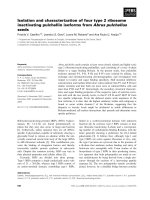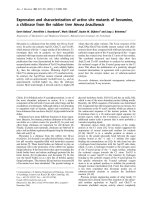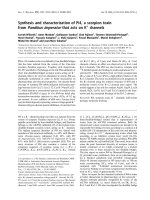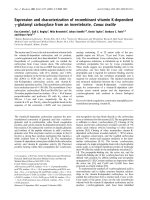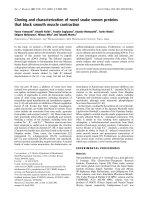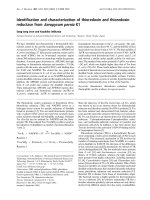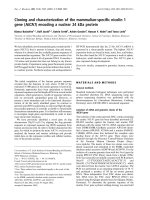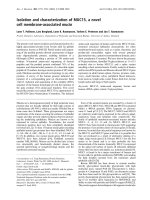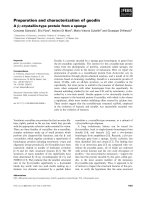Báo cáo y học: "Identification and characterization of the carboxy-terminal region of Sip-1, a novel autoantigen in Behçet''''s disease" docx
Bạn đang xem bản rút gọn của tài liệu. Xem và tải ngay bản đầy đủ của tài liệu tại đây (639.43 KB, 8 trang )
Open Access
Available online />Page 1 of 8
(page number not for citation purposes)
Vol 8 No 3
Research article
Identification and characterization of the carboxy-terminal region
of Sip-1, a novel autoantigen in Behçet's disease
Federica Delunardo
1
, Fabrizio Conti
2
, Paola Margutti
1
, Cristiano Alessandri
2
, Roberta Priori
2
,
Alessandra Siracusano
1
, Rachele Riganò
1
, Elisabetta Profumo
1
, Guido Valesini
2
, Maurizio Sorice
3
and Elena Ortona
1
1
Dipartimento di Malattie Infettive, Parassitarie e Immunomediate, Istituto Superiore di Sanità, Rome, Italy
2
Dipartimento di Clinica e Terapia Medica Applicata, Cattedra di Reumatologia, Università "La Sapienza", Rome, Italy
3
Dipartimento di Medicina Sperimentale e Patologia, Università "La Sapienza", Rome, Italy
Corresponding author: Elena Ortona,
Received: 24 Nov 2005 Revisions requested: 4 Jan 2006 Revisions received: 23 Feb 2006 Accepted: 17 Mar 2006 Published: 12 Apr 2006
Arthritis Research & Therapy 2006, 8:R71 (doi:10.1186/ar1940)
This article is online at: />© 2006 Delunardo et al.; licensee BioMed Central Ltd.
This is an open access article distributed under the terms of the Creative Commons Attribution License ( />),
which permits unrestricted use, distribution, and reproduction in any medium, provided the original work is properly cited.
Abstract
Given the lack of a serological test specific for Behçet's disease,
its diagnosis rests upon clinical criteria. The clinical diagnosis is
nevertheless difficult because the disease manifestations vary
widely, especially at the onset of disease. The aim of this study
was to identify molecules specifically recognized by serum
autoantibodies in patients with Behçet's disease and to evaluate
their diagnostic value. We screened a cDNA library from human
microvascular endothelial cells with serum IgG from two
patients with Behçet's disease and isolated a reactive clone
specific to the carboxy-terminal subunit of Sip1 (Sip1 C-ter).
Using ELISA, we measured IgG, IgM and IgA specific to Sip1
C-ter in patients with various autoimmune diseases
characterized by the presence of serum anti-endothelial cell
antibodies, such as Behçet's disease, systemic lupus
erythematosus, systemic sclerosis and various forms of primary
vasculitis, as well as in patients with diseases that share clinical
features with Behçet's disease, such as inflammatory bowel
disease and uveitis. IgM immunoreactivity to Sip1 C-ter was
significantly higher in patients with Behçet's disease and in
patients with primary vasculitis than in the other groups of
patients and healthy subjects tested (P < 10
-4
by Mann-Whitney
test). ELISA detected IgG specific to Sip1 C-ter in sera from 11/
56 (20%) patients with Behçet's disease, IgM in 23/56 (41%)
and IgA in 9/54 (17%). No sera from patients with systemic
lupus erythematosus, systemic sclerosis, inflammatory bowel
disease, uveitis or healthy subjects but 45% of sera from
patients with primary vasculitis contained IgM specific to Sip1
C-ter. Serum levels of soluble E-selectin, a marker of endothelial
activation and inflammation, correlated with levels of serum IgM
anti Sip-1 C-ter in patients with Behçet's disease (r = 0.36, P =
0.023). In conclusion, Sip1 C-ter is a novel autoantigen in
Behçet's disease. IgM specific to Sip1 C-ter might be useful in
clinical practice as an immunological marker of endothelial
dysfunction in vasculitis.
Introduction
Behçet's disease (BD) is a systemic form of primary vasculitis
characterized by recurrent oral and genital ulcers and ocular
inflammation and with frequent involvement of the joints, cen-
tral nervous system and gastrointestinal tract. Its aetiology is
unknown. The most favoured pathogenetic mechanism is a
genetic susceptibility associated with HLA-B gene polymor-
phisms. Other evidence indicates a pathogenic role for envi-
ronmental factors, including infectious agents or autoimmune
mechanisms [1]. Supporting an immune origin, serum from
patients with BD has been found to contain autoantibodies
directed against several antigens, among them autoantibodies
against the endothelium [2-10]. Because the low specificity
and immunoreactivity of these autoantibodies prevents their
use in diagnosis, no serological test specific for BD is yet avail-
able. The diagnosis is, therefore, based on clinical criteria. The
clinical diagnosis of BD is nevertheless difficult because the
signs and symptoms vary widely, especially at the onset of dis-
ease.
BD = Behçet's disease; ELISA = enzyme-linked immunosorbent assay; HMVEC = human microvascular endothelial cells; IBD = inflammatory bowel
disease; OD = optical density; PBS = phosphate-buffered saline; Sip1 C-ter = carboxy-terminal subunit of Sip1; SLE = systemic lupus erythemato-
sus; SSc = systemic sclerosis
Arthritis Research & Therapy Vol 8 No 3 Delunardo et al.
Page 2 of 8
(page number not for citation purposes)
Our primary aim in this study was to seek and characterize
endothelial autoantigens specifically recognized by serum
autoantibodies in patients with BD that might be a useful tool
in the diagnosis of BD. Because vasculitis in patients with BD
mainly involves capillaries and small vessels, and because
microvascular endothelial cells differ from vein or artery
endothelial cells in phenotype [11,12], we used a human
microvascular endothelial cell (HMVEC) cDNA expression
library to identify target antigens. By screening the library with
sera from two patients with BD we identified a strongly reac-
tive clone encoding the carboxy-terminal subunit of the splic-
ing factor Sip1 (Sip1 C-ter). We then used ELISA to measure
IgG, IgM and IgA specific to Sip1 C-ter in patients with distinct
autoimmune diseases characterized by the presence of serum
anti-endothelial cell antibodies such as BD, systemic lupus
erythematosus (SLE), systemic sclerosis (SSc), various forms
of primary vasculitis as well as in patients with diseases that
share clinical features with BD, such as inflammatory bowel
disease and uveitis. Finally, we evaluated the correlation of
serum antibodies specific to Sip1 C-ter with soluble E-selec-
tin, an established marker of endothelial dysfunction.
Materials and methods
Patients
Fifty-six unselected out-patients with BD (17 women, 39 men;
mean age 37.7 years, range 14 to 58 years; mean disease
duration 8.1 years, range 0 to 24 years) attending the Rheu-
matology Division of the University of Rome "La Sapienza"
were enrolled in the study. All patients fulfilled the diagnostic
criteria of the International Study Group for BD [13]. Informed
consent was obtained from each patient and the local ethics
committee approved the study. Glucocorticoids were used in
46.1% of patients with BD, immunosuppressive drugs
(cyclosporine A, methotrexate, azathioprine, chlorambucil) in
56.4%, infliximab in 5.1%, interferon α in 5.1%, and 10.2% of
the patients with BD were not treated. Patients who had two
of the seven findings (oral and genital ulcerations, skin lesions,
eye involvement, positive pathergy test, thrombophlebitis and
arthritis), or multiple erythema nodosum with severe inflamma-
tion and with both elevated erythrocyte sedimentation rate and
positive C-reactive protein were assumed to have active dis-
ease. According to these criteria, 42% of patients had active
disease. The frequency of the HLAB51 allele was 79%. As
control groups, we also enrolled 32 consecutive patients with
SLE diagnosed in accordance with the American College of
Rheumatology revised criteria for the classification of SLE
[14], 24 consecutive patients with SSc diagnosed in accord-
ance with the criteria of the American Rheumatism Association
[15], 20 patients with primary vasculitis (9 patients with
Wegener's granulomatosis, 4 with Churg-Strauss syndrome,
2 with Takayasu's Arteritis, 2 with Horton disease, 2 with
microscopic poly-angiitis, 1 with panarteritis nodosa), 33
patients with inflammatory bowel disease (IBD), 17 patients
with uveitis (12 with idiopathic diffused uveitis, 5 with idio-
pathic anterior uveitis) and 40 healthy subjects, matched for
sex and age.
Immunoscreening of the cDNA expression library
A commercially available HMVEC cDNA library (Stratagene,
Cambridge, UK) was screened with a pool of sera from 2 of
the 56 patients with BD, essentially as previously described
[16]. The serum was diluted 1:100 in PBS containing 1% milk,
0.1% Tween-20 and 0.02% sodium azide. Positive plaques
were re-screened with the same pool of sera to obtain the
clonality. Immunoreactive cloned phage was recovered as
pBluescript by single-stranded rescue using the helper phage
(Stratagene) according to the manufacturer's instructions and
used to transform SolR XL1 cells. The nucleotide sequence of
the cloned cDNA insertion was sequenced with automated
sequencer ABI Prism 310 collection (Applied Biosystems,
Foster City, CA, USA) and sequences were then compared
with the GenBank sequence database using the Blast pro-
gram.
Expression and purification of the recombinant antigen
The selected cDNA clone was sub-cloned into the BamHI/
HindIII restriction site of the QIA express vector, pQE30. The
fusion protein was expressed in Escherichia coli SG130009
cells, purified by affinity of NI-NTA resin for the six-histidine tail
and eluted under denaturing conditions according to the man-
ufacturer's instruction (Qiagen, GmbH, Hilden, Germany).
SDS-PAGE and immunoblotting
After 12% SDS-PAGE under reducing conditions, immunob-
lotting was performed as previously described [17]. In brief,
the antigen was loaded at concentrations of 3 µg/lane and
was revealed by human sera diluted 1:100 and by a mono-
clonal antibody to six-histidine tail (Qiagen). Peroxidase-conju-
gated goat anti-human and anti-mouse IgG sera (Biorad,
Richmond, CA, USA) were used as second antibodies. Strips
were developed with 3'-3' diaminobenzidine (Sigma-Aldrich,
St Louis, MO, USA).
Purification of specific autoantibodies from patients'
sera
Antigen (50 µg) was spotted onto a nitrocellulose filter and
incubated with a patient's serum that was positive in immuno-
blotting. After washing with PBS-Tween the antibodies were
eluted with glycine 100 mM, pH 2.5, and mixed for 10 minutes.
The eluted antibodies were immediately neutralized with TRIS-
HCl 1 M, pH 8.
Indirect immunofluorescence assay
An indirect immunofluorescence assay was developed on per-
meabilized EAhy-926 endothelial cells, as previously
described [18]. Cells were incubated with purified human anti-
bodies (0.1 µg/µl) in PBS containing 1% bovine serum albu-
min. Fluorescein isothiocyanate-conjugated anti-human IgG
(Sigma) was added and fluorescence was analysed with an
Available online />Page 3 of 8
(page number not for citation purposes)
Olympus U RFL microscope (Olympus, Hamburg, Germany).
Anti-nuclear antibodies were detected using indirect immun-
ofluorescence with Hep2 cells according to the manufac-
turer's instructions (Radim Diagnostic, Rome, Italy). Titers of
more than 1:80 were considered positive.
ELISA
ELISA was developed essentially as previously described
[18]. In brief, polystyrene plates (Dynex, Berlin, Germany) were
coated with the antigen (0.1 µg/well) in 0.05 µM NaHCO
3
buffer, pH 9.5, and incubated overnight at 4°C. Plates were
blocked with 100 µl/well of PBS-Tween containing 3% milk,
for 1 hour at room temperature. Human sera were diluted in
PBS-Tween and 1% milk (1:100 for total IgG and 1:50 for IgM
and IgA), 100 µl per well. Peroxidase conjugates goat anti-
human IgG (Biorad, Richmond, CA, USA), anti-human IgA
(Sigma) and anti-human IgM (ICN Biomedicals, Costa Mesa,
CA, USA) were diluted in PBS-Tween containing 1% milk
(1:3,000, 1:3,000 and 1:500 respectively) and incubated 1
hour at room temperature. O-phenylenediamine dihydrochlo-
Figure 1
Nucleotide, amino acid sequence and immunochemical characterization of the carboxy-terminal region of Sip1Nucleotide, amino acid sequence and immunochemical characterization of the carboxy-terminal region of Sip1. (a) The nucleotide sequence con-
taining 1,281 base-pairs of the cloned cDNA insertion was sequenced with an automated sequencer ABI Prism 310 Collection. The amino acid
sequence predicted from the nucleotide sequence is 109 residues long. (Sip1 C-ter; GenBank accession number for Sip1 cDNA is AF030234) (b)
The molecular size and the purity of the expressed protein was confirmed by 12% SDS-PAGE stained by Coomassie blue (lane 1) and the patients'
serum immunoreactivity was analyzed by immunoblotting. Lane 2, the monoclonal antibody anti-histidine tail; lane 3, serum pool from the two patients
with BD used in screening the library; lane 4, representative serum from a healthy subject; lane 5, control lane without serum. (c) Immunofluores-
cence analysis of Sip1 localization in EAhy-926 endothelial cells. The human IgG antibodies purified from patient's serum specific to Sip1 C-ter were
used to analyse the cellular distribution of Sip1.
Arthritis Research & Therapy Vol 8 No 3 Delunardo et al.
Page 4 of 8
(page number not for citation purposes)
ride (Sigma) was used as a substrate and optical density (OD)
was measured at 490 nm. Means + 2 standard deviations of
the OD reading of the healthy controls were considered as
cut-off level for positive reactions. All assays were performed
in quadruplicate. Data were presented as the mean OD cor-
rected for background (wells without coated antigen). The
results of unknown samples on the plate were accepted if
internal controls (two serum samples, one positive and one
negative) had an absorbance reading within mean ± 10% of
previous readings. To inhibit specific IgG, IgM and IgA, the
sera from two patients with BD were incubated overnight at
room temperature with 10 µg/ml of Sip1 C-ter according to
the method reported by Huang and colleagues [19]. As a neg-
ative control, the sera was pre-incubated with 40 µg/ml of
bovine serum albumin.
Soluble E-selectin was detected using a sandwich ELISA kit
(R&D Systems, Minneapolis, MN, USA). ELISA was performed
in accordance with the manufacturer's instructions.
Statistical analysis
Chi-square analysis was used to evaluate differences between
percentages; Kruskal Wallis non-parametric ANOVA test and
the Mann-Whitney unpaired test were used to compare quan-
titative variables. P values less than 0.05 were considered to
indicate statistical significance. Pearson correlation (r correla-
tion coefficient) and linear regression analysis were used to
determine if the levels of soluble serum E-selectin correlated
with the levels of anti-Sip1 C-ter antibodies in patients with BD
Results
Immunoscreening of the HMVEC expression library
Immunoscreening of the HMVEC expression library with IgG
from the serum pool of two patients with BD identified one
strongly reactive clone. The amino acid sequence of the clone,
predicted from the 1,281 base-pair open reading frame of this
clone, is 427 residues long and has 100% identity with the
carboxy-terminal subunit of the splicing factor Sip1 (Figure
1a). The expected molecular size of 48 kDa, the purity and the
immunoreactivity of the expressed protein were confirmed by
12% SDS-PAGE and immunoblotting (Figure 1b). The nuclear
localization of Sip1 in endothelial cells was observed in
immunofluorescence with patients' antibodies purified from
recombinant antigen (Figure 1c).
ELISA for IgG, IgM and IgA specific to Sip1 C-ter
Serum IgM, IgG and IgA immunoreactivity to Sip1 C-ter dif-
fered significantly between the groups examined (P < 10
-4
by
Kruskal-Wallis test). Serum IgM immunoreactivity to Sip1 C-
ter was significantly higher in patients with BD and in patients
with other primary vasculitis than in those with SLE, SSc, IBD,
uveitis and healthy subjects (P < 10
-4
by Mann-Whitney) (Fig-
ure 2a). Serum IgG immunoreactivity to Sip1 C-ter was higher
in patients with BD than in the other groups tested, but the dif-
ference was significant only versus patients with SLE and with
Figure 2
Anti-Sip1 C-ter antibodies in patients and healthy subjectsAnti-Sip1 C-ter antibodies in patients and healthy subjects. Anti-car-
boxy-terminal subunit of Sip1 (anti-Sip1 C-ter) antibodies in patients
with Behçet's disease (BD), systemic lupus erythematosus (SLE), sys-
temic sclerosis (SSc), vasculitis, inflammatory bowel disease (IBD),
uveitis and from healthy donors. Median, quartiles, range, and possibly
extreme values are indicated. The broken line represents the cutoff
(mean + 2 standard deviations for the healthy controls). Outliers are
represented as solid circles. (a) Box-whisker plot of anti-Sip1 C-ter IgM
(
§
P < 10
-4
for BD versus SLE, BD versus SSc, BD versus IBD, BD ver-
sus uveitis, BD versus healthy donors). (b) Box-whisker plot of anti-
Sip1 C-ter IgG (
†
P = 0.001 for BD versus SLE;
‡
P = 0.033 for BD ver-
sus vasculitis). (c) Box-whisker plot of anti-Sip1 C-ter IgA (*P < 10
-4
for
BD versus SLE, BD versus healthy donors, BD versus IBD;
#
P = 0.012
for BD versus vasculitis). OD, optical density.
Available online />Page 5 of 8
(page number not for citation purposes)
vasculitis (P = 0.001 and P = 0.033, respectively, by Mann-
Whitney) (Figure 2b). Serum IgA immunoreactivity was signif-
icantly higher in patients with BD than in those with SLE, with
the other forms of primary vasculitis, with IBD and in healthy
subjects (P < 10
-4
for BD versus SLE, BD versus healthy sub-
jects, BD versus IBD; P = 0.012 for BD versus vasculitis by
Mann-Whitney) (Figure 2c). The pre-absorption of sera from
two patients with BD with Sip1 C-ter itself completely inhib-
ited the antibody reactivity, confirming the specificity of ELISA
(data not shown).
ELISA detected IgG specific to Sip1 C-ter in 11/56 (20%)
patients with BD, IgM in 23/56 (41%) and IgA in 9/54 (17%).
We found IgM specific to Sip1 C-ter in sera from 9/20 (45%)
patients with primary vasculitis but in no sera from patients
with SLE, SSc, IBD, uveitis or healthy subjects (Table 1).
In patients with BD, we found no significant association
between detectable autoantibodies to Sip1 C-ter and clinical
manifestations, in particular vascular manifestations (venous
and arterial thrombosis, cutaneous or visceral vasculitis)
(Table 2). We found no significant association between anti-
Sip1 C-ter antibodies and disease activity, therapeutic regi-
men or HLA B51 expression.
Immunofluorescence analysis detected anti-nuclear antibod-
ies in 7 of the 56 patients with BD (12.5%) at low titer (from
1:80 to 1:160). Five of these seven positive patients had
serum antibodies specific to Sip1 C-ter (two patients had
serum anti-Sip1 C-ter IgM, two anti-Sip1 C-ter IgM and IgG
and one anti-Sip1 C-ter IgM and IgA).
Table 1
Distribution of anti-Sip1 C-ter antibodies in sera from patients and from healthy donors
Serum samples Number of total samples Anti-Sip1 C-ter antibody response, number of positive samples (%)
IgG IgM IgA
Behçet's disease 56 11 (20) 23 (41) 9 (17)
Systemic lupus erythematosus 32 2 (6) 0 (0) 0 (0)
Systemic sclerosis 24 1 (4) 0 (0) 4 (17)
Primary vasculitis 20 1 (5)
a
9 (45)
b
3 (15)
c
Inflammatory bowel disease 32 1 (3) 0 (0) 1 (3)
Uveitis 17 2 (11) 0 (0) 4 (23)
Healthy donors 40 2 (5) 0 (0) 3 (7)
Sip1 C-ter, carboxy-terminal subunit of Sip1.
a
One patient with microscopic poly-angiitis;
b
four patients with Wegener granulomatosis, two with Takayasu's arteritis, two with microscopic
poly-angiitis and one with Horton disease;
c
one patient with Wegener granulomatosis, one with Churg-Strauss syndrome and one with
Takayasu's Arteritis
Table 2
Clinical manifestations of patients with Behçhet's disease in relation to anti-Sip1 C-ter autoantibodies
Clinical manifestation of the 56
patients with Behçet's disease
Number of total samples
(%)
Anti-Sip1 C-ter antibody response, number of positive samples (%)
IgG IgM IgA
Skin lesions 36 (64) 7 (19) 14 (39) 7 (19)
Ocular inflammation 38 (68) 8 (21) 16 (42) 5 (13)
Genital aphtosis 27 (48) 5 (18) 8 (29) 5 (18)
Arthritis 10 (18) 1 (10) 6 (60) 2 (20)
Vascular manifestations 10 (18) 4 (40) 6 (60) 4 (40)
Neurological manifestations 6 (11) 0 1 (1.6) 0
Sip1 C-ter, carboxy-terminal subunit of Sip1.
Arthritis Research & Therapy Vol 8 No 3 Delunardo et al.
Page 6 of 8
(page number not for citation purposes)
In patients with BD, we detected a significant positive correla-
tion between serum IgM specific to Sip1 C-ter and soluble E-
selectin serum levels (r = 0.36, P = 0.023; Figure 3), whereas
we found no significant correlation between anti-Sip1 IgG and
IgA and soluble E-selectin.
Discussion
In this study, by screening an HMVEC cDNA expression library
to identify target antigens, we identified a strongly reactive
clone encoding the carboxy-terminal subunit of the splicing
factor Sip1 (Sip1 C-ter). The carboxy-terminal region of Sip1
– a novel endothelial autoantigen recognized by serum autoan-
tibodies in patients with BD – may be a marker of endothelial
dysfunction in vascular autoimmune diseases.
To our knowledge, this is the first report describing an immune
response against the protein Sip1. Sip1 is a nuclear splicing
factor containing an arginine/serine-rich domain and a RNA-
binding motif that may play a role in linking the processes of
transcription and pre-mRNA splicing [20]. How Sip1 might
become an autoantigen exposed to the immune system and
whether this process involves apoptosis need further investi-
gations.
Apoptosis of endothelial cells may be initially induced by
inflammation or oxidative stress caused by intrinsic or extrinsic
factors. In this environment, mature dendritic cells would proc-
ess and present Sip1, among other intracellular antigens, to
autoreactive lymphocytes, thereby triggering the production of
autoantibodies. Antibodies specific to Sip1 could in turn
induce additional cellular damage by activating complement or
through their cytotoxic properties, penetrating living cells. They
might also merely reflect an immune response against anti-
gens released from damaged endothelium. Another possible
explanation for the immune response to Sip1 is molecular mim-
icry. Again, further investigations will clarify the possible cross-
reaction with molecules from microorganisms associated with
BD and Sip1. Using a molecular strategy to identify autoanti-
gens in BD, Lu and colleagues [4] immunoscreened a T24
cDNA expression library and identified kinectin as a BD
autoantigen. Presumably our study and that of Lu and col-
leagues identified different molecular targets because the
cDNA libraries and patient populations differed.
In this study, we used ELISA to analyse Sip1 C-ter immunore-
activity to IgG, IgA and IgM, three immunoglobulin classes
potentially involved in the pathogenesis of BD. Kruskal-Wallis
test showed that the immunoreactivity of IgM, IgG and IgA
specific to Sip1 C-ter varied significantly among various
groups of patients analysed. The precise significance of the
isotypes of anti-Sip1 antibodies and their potentially independ-
ent clinical role remains unclear.
Another important question to clarify is whether distinct
autoantibody isotypes recognize different Sip1 epitopes. IgM
specific to Sip1 C-ter achieved the highest prevalence and the
highest specificity in patients with BD and with vasculitis.
Autoimmune diseases can be associated with elevated levels
of IgM autoantibodies that may have a pathogenic effect [21].
In particular, IgM antibodies might have an important role in the
pathogenesis of BD and high IgM deposition has been found
in papulopustular lesions, the most common type of cutaneous
lesions in BD and in the vessels of the lesional skin [22].
In patients with BD, anti-endothelium IgM is more frequent
than anti-endothelium IgG and is associated with vasculitis
[23]. In a recent study using proteomic technology to identify
a protein of human dermal microvascular endothelial cells that
reacts with anti-endothelial cell antibodies of patients with BD,
Lee and colleagues [2] identified α-enolase, another ubiqui-
tous protein, as an autoantigen recognized by serum IgM from
patients with BD, thus confirming the importance of anti-
endothelium IgM in BD.
The target antigens, Sip1 in our study and α-enolase in the
study by Lee and colleagues, were recognized only by IgM of
patients with BD and patients with other forms of primary vas-
culitis, whereas no serum from patients with other autoimmune
diseases or from healthy subjects had specific IgM with an OD
reading in ELISA higher than the cutoff level. The presence of
IgM specific to Sip1 only in the sera from patients with primary
vascular disease as well as the positive correlation of serum
IgM specific to Sip1 C-ter with the serum levels of soluble E-
selectin, a typical marker of endothelial activation and inflam-
mation, suggests the potential role of these antibodies as
immunological markers of endothelial dysfunction [24].
Figure 3
Correlation and linear regression of soluble E-selectin and anti-Sip1 C-ter IgM.lCorrelation and linear regression of soluble E-selectin and anti-Sip1 C-
ter IgM.l. Correlation and linear regression of soluble E-Selectin (ng/ml)
and serum IgM specific to the carboxy-terminal subunit of Sip1 (optical
density (OD) 490 nm) in patients with Behçet's disease, correlation
coefficient r = 0.36, P = 0.023.
Available online />Page 7 of 8
(page number not for citation purposes)
The role of IgA specific to Sip1 C-ter in patients with various
diseases needs further investigation in a larger sample of
patients. Because IgA is a poor activator of complement, this
class of immunoglobulins may have a protective function inhib-
iting complement activation by blocking the binding of IgG or
IgM antibodies [25]. Although Sip1 is a nuclear protein, in
patients with BD we found no association between serum anti-
Sip1 antibodies and anti-nuclear antibodies, probably
because we used different techniques to reveal the two anti-
bodies. Further studies are in progress to clarify the effective
role of anti-Sip 1 antibodies in vivo and to provide new insights
into their potential pathogenicity.
Conclusion
One way of improving the diagnosis of BD is to characterize
new autoantigens for use in immunodiagnostic tests. In this
study, we identified Sip1 C-ter as a novel autoantigen in BD.
Anti-Sip1 C-ter IgM should be useful as a marker of endothelial
dysfunction in vasculitis. This recombinant antigen might also
provide new insights into the role of specific autoantibodies in
the autoimmune mechanisms underlying the pathogenesis of
BD.
Competing interests
EO, PM and FD are applying for a patent of Istituto Superiore
di Sanità relating to content of the manuscript.
Authors' contributions
FD screened the library, conducted the ELISA experiments
and participated in the design of the study and analysis of the
data. FC participated in the design of the study and in the anal-
ysis of data and helped to draft the manuscript. PM cloned and
sequenced cDNA, purified the recombinant protein and
helped to interpret the data. CA participated in the design and
revision of the study and performed the statistical analysis. RP
participated in the design and revision of the study. AS partic-
ipated in the analysis and interpretation of data and helped to
draft the manuscript. RR participated in the design of the study
and in the revision of the manuscript. EP participated in analy-
sis of data. GV participated in the design of the study and in
the revision of the manuscript. MS conducted the experiments
on endothelial cell lines, participated in the design of the study
and helped to draft the manuscript. EO conceived the study,
participated in its design and coordination and drafted the
manuscript. All authors read and approved the final manu-
script.
Acknowledgements
We thank Professor Francesco Vecchi for assistance with statistical
analysis. This work was supported by an ISS grant n. C3N3 and AE13.
References
1. Marshall SE: Behçet's disease. Best Pract Res Clin Rheumatol
2004, 18:291-311.
2. Lee KH, Chung HS, Kim HS, Oh SH, Ha MK, Baik JH, Lee S, Bang
D: Human alpha-enolase from endothelial cells as a target
antigen of anti-endothelial cell antibody in Behçet's disease.
Arthritis Rheum 2003, 48:2025-2035.
3. Priori R, Conti F, Pittoni V, Garofalo T, Sorice M, Valesini G: Is
there a role for anti-phospholipid-binding-protein antibodies
in the pathogenesis of thrombosis in Behçet's disease?
Thromb Haemost 2000, 83:173-174.
4. Lu Y, Ye P, Chen S, Tan EM, Chan EKL: Identification of kinectin
as a novel Behçet's disease autoantigen. Arthritis Res Ther
2005, 7:R1133-R1139.
5. Navarro M, Cervera R, Font J, Reverter JC, Monteagudo J, Escolar
G, Lopez-Soto A, Ordinas A, Ingelmo M: Anti-endothelial cell
antibodies in systemic autoimmune diseases: prevalence and
clinical significance. Lupus 1997, 6:521-526.
6. Lehner T, Lavery E, Smith R, van der Zee R, Mizushima Y, Shinnick
T: Association between the 65-kilodalton heat shock protein,
Streptococcus sanguis, and the corresponding antibodies in
Behçet's syndrome. Infect Immun 1991, 59:1434-1441.
7. Matsui T, Otsuka M, Maenaka K, Furukawa H, Yabe T, Yamamoto
K, Nishioka K, Kato T: Detection of autoantibodies to killer
immunoglobulin-like receptors using recombinant fusion pro-
teins for two killer immunoglobulin-like receptors in patients
with systemic autoimmune diseases. Arthritis Rheum 2001,
44:384-388.
8. Mor F, Weinberger A, Cohen IR: Identification of alpha-tropomy-
osin as a target self-antigen in Behçet's syndrome. Eur J
Immunol 2002, 32:356-365.
9. Matsui T, Kurokawa M, Kobata T, Oki S, Azuma M, Tohma S, Inoue
T, Yamamoto K, Nishioka K, Kato T: Autoantibodies to T cell cos-
timulatory molecules in systemic autoimmune diseases. J
Immunol 1999, 162:4328-4335.
10. Orem A, Cimsit G, Deger O, Vanizor B, Karahan SC: Autoanti-
bodies against oxidatively modified low-density lipoprotein in
patients with Behçet's disease. Dermatology 1999,
198:243-246.
11. Ribatti D, Nico B, Vacca A, Roncali L, Dammacco F: Endothelial
cell heterogeneity and organ specificity. J Hematother Stem
Cell Res 2002, 11:81-90.
12. Shoenfeld Y: Classification of anti-endothelial cell antibodies
into antibodies against microvascular and macrovascular
endothelial cells: the pathogenic and diagnostic implications.
Cleve Clin J Med 2002, 69(Suppl 2):SII65-67.
13. International Study Group for Behçet's Disease: Criteria for diag-
nosis of Behçet's Disease. Lancet 1990, 335:1078-1080.
14. Hochberg MC: Updating the American College of Rheumatol-
ogy revised criteria for the classification of systemic lupus ery-
thematosus. Arthritis Rheum 1997, 40:1725.
15. Subcommittee for Scleroderma Criteria of the American Rheuma-
tism Association Diagnostic and Therapeutic Criteria Committee:
Preliminary criteria for the classification of systemic sclerosis
(scleroderma). Arthritis Rheum 1980, 23:581-590.
16. Margutti P, Delunardo F, Sorice M, Valesini G, Alessandri C,
Capoano R, Profumo E, Siracusano A, Salvati B, Riganò R, Ortona
E: Screening of a HUAEC cDNA library identifies actin as a
candidate autoantigen associated with carotid atherosclero-
sis. Clin Exp Immunol 2004, 137:209-215.
17. Margutti P, Ortona E, Vaccari S, Barca S, Riganò R, Teggi A, Muh-
schlegel F, Frosch M, Siracusano A: Cloning and expression of
a cDNA encoding an elongation factor 1 β/δ protein from Echi-
nococcus granulosus with immunogenic activity. Parasite
Immunol 1999, 21:485-492.
18. Margutti P, Sorice M, Conti F, Delunardo F, Racaniello M, Alessan-
dri C, Siracusano A, Riganò R, Profumo E, Valesini G, Ortona E:
Screening of an endothelial cDNA library identifies the car-
boxy-terminal region of Nedd5 as a novel autoantigen in sys-
temic lupus erythematosus with psychiatric manifestations.
Arthritis Res Ther 2005, 7:R896-R903.
19. Huang X, Johansson SGO, Zargari A, Zargari A, Nordvall SL:
Allergen cross-reactivity between Pityrosporum orbiculare and
Candida albicans. Allergy 1995, 50:648-656.
20. Zhang WJ, Wu JY: Sip1, a novel RS domain-containing protein
essential for pre-mRNA splicing. Mol Cell Biol 1998,
18:676-684.
21. Boes M: Role of natural and immune IgM antibodies in immune
responses. Mol Immunol 2000, 37:1141-1149.
22. Alpsoy E, Uzun S, Akman A, Acar MA, Memisoglu HR, Basaran E:
Histological and immunofluorescence findings of non-follicu-
Arthritis Research & Therapy Vol 8 No 3 Delunardo et al.
Page 8 of 8
(page number not for citation purposes)
lar papulopustular lesions in patients with Behçet's disease. J
Eur Acad Dermatol Venereol 2003, 17:521-524.
23. Lee KH, Bang D, Choi ES, Chun WH, Lee ES, Lee S: Presence of
circulating antibodies to a disease-specific antigen on cul-
tured human dermal microvascular endothelial cells in
patients with Behçet's disease. Arch Dermatol Res 1999,
291:374-381.
24. Sari RA, Kiziltunc A, Taysy S, Akdemyr S, Gundogdu M: Levels of
soluble E-selectin in patients with active Behçet's disease.
Clin Rheumatol 2005, 24:55-59.
25. Woof JM, Kerr MA: The function of immunoglobulin A in immu-
nity. J Pathol 2006, 208:270-282.
